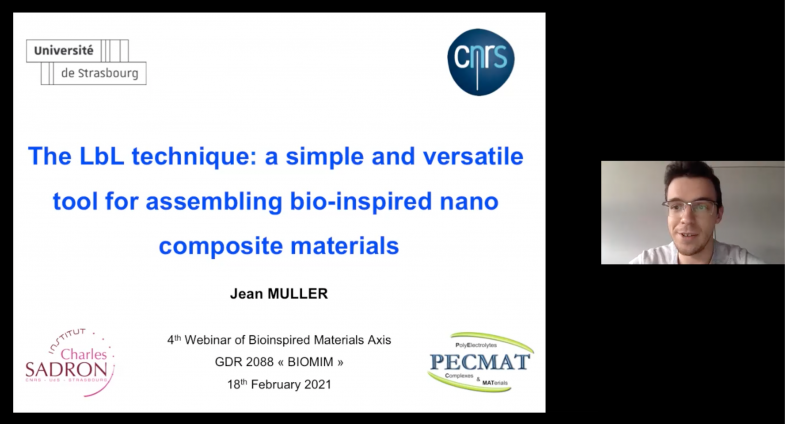Title : LbL technique: a simple and versatile tool for assembling bio-inspired nanocomposite materials with anisotropic properties
Speaker’s name and lab : Jean MULLER, PhD student / PECMAT, Institut Charles Sadron, Université de Strasbourg
Date / hour : February 18th 2021, 2pm
Zoom Meeting informations : https://univ-grenoble-alpes-fr.zoom.us/j/94823009804?pwd=YTlaMUxCSUNDM1JOZlJNTXNWU05JUT09
Abstract
The remarkable properties of natural composite materials (e.g. plant cell wall, animal exoskeleton) have attracted a wealth of research to understand their structure-properties relations at all length scales and to design novel materials with superior performance. However, while nature masters the organization of anisotropic nano-objects like nanocelluloses into complex superstructures, the development of synthetic nanocomposite materials with complex and precisely controlled architectures (e.g. helical) has proven to be difficult due to the lack of suitable approaches for their preparation.
With respect to the preparation of multimaterial thin films with a high level of control over the spatial positioning of their constituents, Layer-by-Layer (LbL) assembly has gained its merits as a simple and highly versatile nanofabrication method. While the sequence of components in layered multimaterial films can be very well controlled by LbL-assembly, tuning of the in-plane anisotropy has not yet been achieved.
Recently, we have introduced a method called “Grazing Incidence Spraying” for the in-plane alignment of anisotropic nanoparticles (cellulose nanofibrils, metallic nanowires and nanorods, …) on large areas. Its combination with the LbL-approach permits to extend it toward the preparation of complex (e.g. helical) multilayer films in which the composition and orientation can be controlled independently in each layer.
The talk will illustrate some of our recent results on the design of complex bio-inspired nanostructured materials combining hard anisotropic elements like cellulose nanofibrils with soft polymer building blocks. The preparation of such thin films will be presented and their optical and mechanical properties will be discussed as function of the film composition and geometry with a special emphasis on helical superstructures, which display chiroptical activity.
